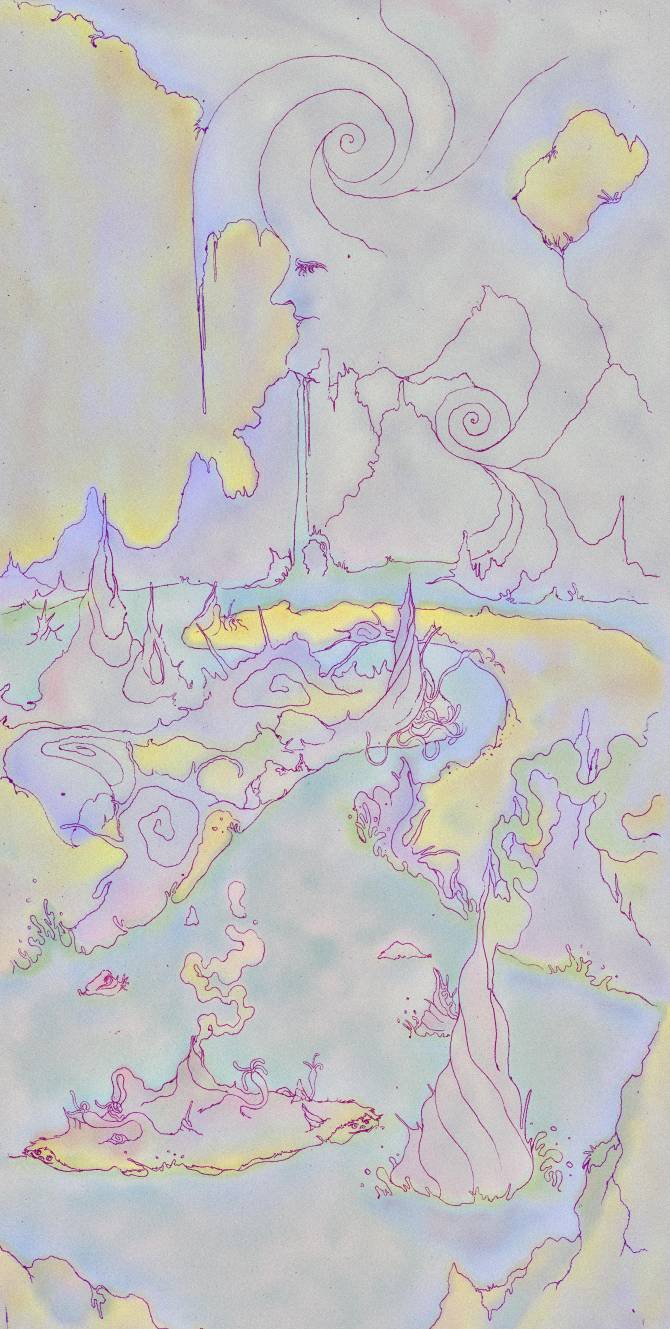Actifs sous le nom de Tengger depuis 2013, Itta et Marqido, accompagnés par leur fils Raii, sont une famille de musiciens et de voyageurs coréano-japonaise basée à Séoul.

Ils développent depuis cinq ans à travers leur pratique musicale et leurs voyages (conçus comme des experiences spirituelles) un univers riche, dans lequel chacun de leurs albums, performances, concerts et autres projets nous invitent à naviguer.
Leur dernier album en date « Segye » est sorti sur le label néerlandais Guruguru Brain. Sa confection a été considérablement influencée par la proximité qu’avait le studio d’enregistrement avec le lieux où prit place la mobilisation populaire conduisant à la destitution de la présidente Geun-hye Park au cours des mois d’octobre et de novembre 2016.
A l’occasion de cette nouvelle carte blanche sur l’antenne Sept de la r22, Itta et Marqido on réalisé shanshui, une pièce qui s’inspire d’un concept d’abord appliqué à l’art pictural Chinois, coréen et japonais (1) , et dont ils livrent ici leur interprétation toute personnelle, à l’exact opposé d’une carte postale sonore, dans les nappes et les volutes hypnotiques
du synthétiseur de Marqido, des profondeurs desquelles surgissent les motifs lumineux de l’harmonium indien d’Itta auxquels répond sa voix éthérée.

Illustration réalisée par Paul Descamps d’après la pièce de Tengger et le concept de shanshui.
*Le terme sansuiga 山水画 désigne la peinture chinoise coréenne et japonaise représentant une image idéalisée de la nature, en utilisant principalement des formes de montagnes, de rivières, de nuages, et des éléments naturels comme des rochers et des arbres. C’est l’un des 3 thèmes majeurs de la peinture extreme orientale, avec la peinture de personnages jinbutsuga 人物画 ainsi que la peinture de fleurs et d’oiseaux kachouga 花鳥画. Souvent considérée comme la plus caractéristique de la tradition picturale chinoise, la peinture de paysage n’est pas pensée commeun miroir du monde naturel, mais plutôt un moyen d’expression de la pensée humaine et de concepts abstraits et/ou philosophiques.
source

[ENGLISH]
Active under the name of Tengger since 2013, Itta (from Korea) Marqido (from Japan) and their son Raii, are a traveller and musician family based in Seoul. For five years they have been exploring through their musical practice and their travels (envisioned as spiritual
experiences in real environments) a rich and diverse world, in which each of their albums, performances, concerts and other project invite us to wander.
Tengger’s most recent album, « Segye » was released on dutch label Guruguru Brain. It’s making was heavily influenced by the proximity between the recording studio and the location where popular protests leading to the destitution of president Park Geun-hye took place, between October and November of 2016. For this new Carte Blanche on Sept (1),
Itta and Marqido did craft an original sound piece called « Shanshui », based on a concept that takes its roots in Chinese Korean and Japanese painting (2). They deliver here their
very own interpretation of 山水, far away from the sonic postcard that one could expect, in the profound layers of tones and hypnotic volutes and swirls of Marqido’s modular synthesizer, from which depths Itta’s Indian harmonium luminous patterns arise, followed by her ethereal voice, seeming to echo and answer it.
The illustration was created by french illustrator Paul Descamps, inspired by Tengger’s sound piece and shanshui painting style and concept.
(1) Sept is a virtual (and sometime concrete) place dedicated to the development and sharing of experimental music practices. It was initiated a year and a half ago by Victor Donati, and is currently active as an « antenna » of R22 tout monde (a french webradio founded by
Khiasma independent art center, based in Les Lilas 93260)
(2) The term sansuiga 山水画 is applied to Chinese, Korean, and Japanese painting which depicts an idealized image primarily using the forms of mountains, rivers, clouds and natural features such as rocks and trees. One of the three major subject categories of Far Eastern painting, along with figure painting jinbutsuga 人物画 and bird and flower painting kachouga 花鳥画. (Although the representation of landscape had a long history in China, only in the 11c did it become the dominant subject of mainstream painting.) Sometimes called the most characteristic or the chief glory of the entire Chinese painting tradition, landscape painting is said to provide not only a mirror of the natural world but a means of expressing human thought and abstract or philosophical principles.
source
composé et mixé par Tengger
illustrations: Paul Descamps
Auteur·ice
Programme
Antenne
Reliées
-
Musique de bela pour le programme : Cartes blanches et pour l'antenne : Sept
-
PEUR(S) : spiritualités et ancestralités à l'ère postcoloniale
- Langues : Anglais & Français
- Conférence
- Création sonore
- Performance
- Rennes • France
des Conférence & Création sonore & Performance pour l'antenne : Maison des Diasporas
![SHANSHUI [carte blanche à Tengger partie 1]](https://www.r22.fr/media/pages/antennes/sept/cartes-blanches/shanshui/b655efd755-1582723562/cover-1200x600-crop-50-50-q80.jpg)




